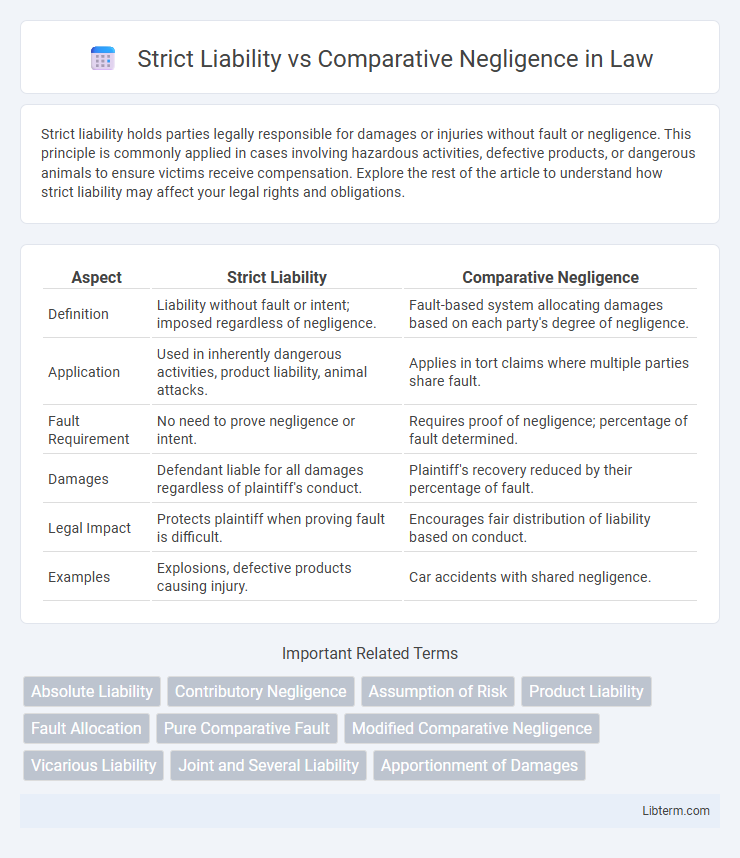Strict liability holds parties legally responsible for damages or injuries without fault or negligence. This principle is commonly applied in cases involving hazardous activities, defective products, or dangerous animals to ensure victims receive compensation. Explore the rest of the article to understand how strict liability may affect your legal rights and obligations.
Table of Comparison
| Aspect | Strict Liability | Comparative Negligence |
|---|---|---|
| Definition | Liability without fault or intent; imposed regardless of negligence. | Fault-based system allocating damages based on each party's degree of negligence. |
| Application | Used in inherently dangerous activities, product liability, animal attacks. | Applies in tort claims where multiple parties share fault. |
| Fault Requirement | No need to prove negligence or intent. | Requires proof of negligence; percentage of fault determined. |
| Damages | Defendant liable for all damages regardless of plaintiff's conduct. | Plaintiff's recovery reduced by their percentage of fault. |
| Legal Impact | Protects plaintiff when proving fault is difficult. | Encourages fair distribution of liability based on conduct. |
| Examples | Explosions, defective products causing injury. | Car accidents with shared negligence. |
Introduction to Strict Liability and Comparative Negligence
Strict liability holds a party responsible for damages caused by their actions or products, regardless of intent or negligence, primarily applied in cases involving inherently dangerous activities or defective products. Comparative negligence allocates fault between parties based on the degree of negligence each party contributed to the harm, reducing the plaintiff's recovery proportionally. Understanding these doctrines is essential for determining liability and damages in personal injury and tort law cases.
Defining Strict Liability: Key Legal Concepts
Strict liability holds a party legally responsible for damages or injuries caused by their actions or products, regardless of fault or intent, primarily applied in cases involving inherently dangerous activities or defective products. This doctrine shifts the burden of proof, requiring the plaintiff only to demonstrate that the harm occurred and the defendant's involvement, without needing to prove negligence. Strict liability ensures accountability and consumer protection by emphasizing risk management and safety standards over fault-based assessments.
Understanding Comparative Negligence: Core Principles
Comparative negligence allocates fault between parties based on their respective contributions to an accident, allowing plaintiffs to recover damages reduced by their percentage of fault. This principle contrasts with strict liability, which holds defendants liable regardless of fault. Understanding comparative negligence is crucial for assessing legal responsibility and calculating compensation in personal injury cases.
Key Differences Between Strict Liability and Comparative Negligence
Strict liability holds a party responsible for damages without proof of fault or negligence, primarily used in cases involving inherently dangerous activities or defective products. Comparative negligence assigns fault proportionally, reducing a plaintiff's compensation based on their degree of responsibility for the injury. The key difference lies in strict liability eliminating the need to prove negligence, while comparative negligence requires assessing and apportioning fault between parties.
Situations Where Strict Liability Applies
Strict liability applies primarily in cases involving inherently dangerous activities, such as using explosives or keeping wild animals, where the defendant is liable regardless of fault or intent. Product liability claims, especially for defective or dangerous products causing injury, often fall under strict liability to protect consumers. Environmental law also enforces strict liability for hazardous spills or pollution to ensure accountability without proving negligence.
When Comparative Negligence Governs Legal Outcomes
Comparative negligence governs legal outcomes when both parties share fault in an accident, allowing courts to allocate damages based on the degree of each party's responsibility. Unlike strict liability, which imposes fault regardless of negligence, comparative negligence adjusts compensation proportionally, reducing the plaintiff's recovery by their percentage of fault. This principle is crucial in tort cases such as personal injury and property damage, where assessing fault levels determines the final award.
Impact on Plaintiffs and Defendants
Strict liability holds defendants fully accountable for damages regardless of fault, providing plaintiffs with a straightforward path to compensation, especially in cases like product liability or abnormally dangerous activities. Comparative negligence allocates fault between plaintiffs and defendants based on their degree of responsibility, reducing the plaintiff's recovery proportionally and encouraging more nuanced assessments of negligence. This legal distinction significantly impacts litigation strategies, insurance claims, and the predictability of outcomes for both parties involved.
Real-World Case Examples
In the landmark case of Rylands v Fletcher, strict liability was established when the defendant's reservoir burst, causing damage to the plaintiff's property without requiring proof of negligence. In contrast, the famous case of Li v. Yellow Cab Co. applied comparative negligence, reducing the plaintiff's compensation percentage based on their own partial fault in the automobile accident. These cases illustrate strict liability's focus on the defendant's responsibility regardless of fault and comparative negligence's approach to apportioning damages according to the degree of each party's fault.
Legal Strategies Under Each Doctrine
Legal strategies under strict liability prioritize proving the defendant's engagement in inherently hazardous activities or defective product distribution, eliminating the need to establish negligence. In comparative negligence cases, attorneys emphasize quantifying each party's percentage of fault to reduce client liability proportionally. Effective defense requires tailored approaches: under strict liability, challenging product defect evidence, while in comparative negligence, presenting evidence of the plaintiff's contributory misconduct is crucial.
Choosing the Right Approach in Personal Injury Cases
Choosing between strict liability and comparative negligence in personal injury cases depends on the nature of the incident and evidence of fault. Strict liability imposes responsibility without proof of negligence, typically used in cases involving inherently dangerous activities or defective products. Comparative negligence allocates damages based on each party's degree of fault, optimizing recovery when both plaintiff and defendant share responsibility.
Strict Liability Infographic

 libterm.com
libterm.com